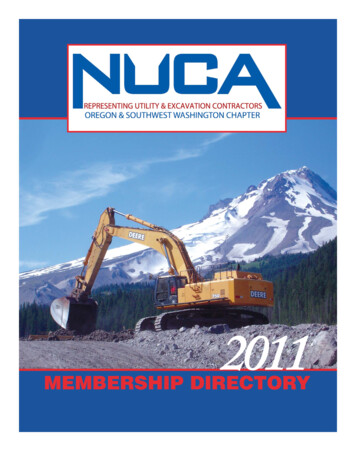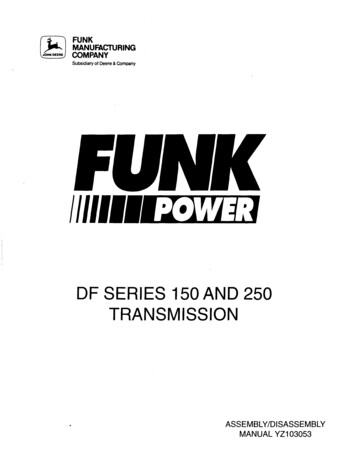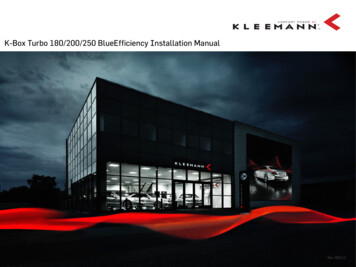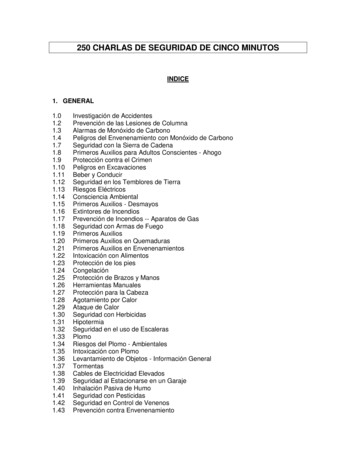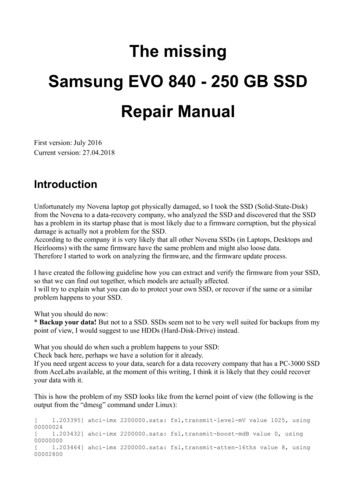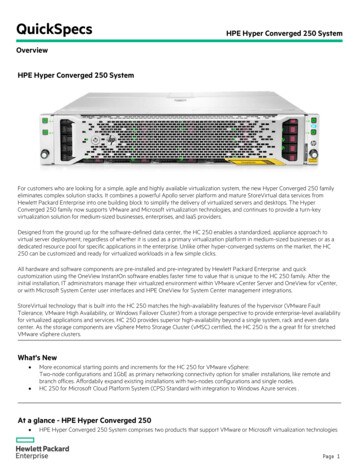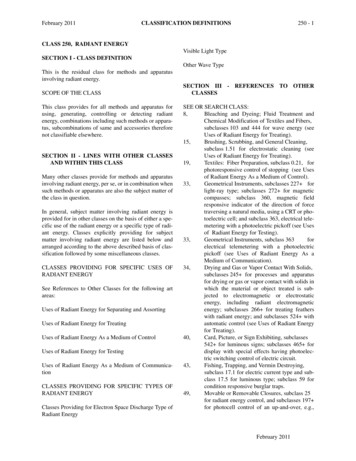
Transcription
February 2011CLASSIFICATION DEFINITIONS250 - 1CLASS 250, RADIANT ENERGYVisible Light TypeSECTION I - CLASS DEFINITIONOther Wave TypeThis is the residual class for methods and apparatusinvolving radiant energy.SCOPE OF THE CLASSThis class provides for all methods and apparatus forusing, generating, controlling or detecting radiantenergy, combinations including such methods or apparatus, subcombinations of same and accessories thereforenot classifiable elsewhere.SECTION II - LINES WITH OTHER CLASSESAND WITHIN THIS CLASSMany other classes provide for methods and apparatusinvolving radiant energy, per se, or in combination whensuch methods or apparatus are also the subject matter ofthe class in question.In general, subject matter involving radiant energy isprovided for in other classes on the basis of either a specific use of the radiant energy or a specific type of radiant energy. Classes explicitly providing for subjectmatter involving radiant energy are listed below andarranged according to the above described basis of classification followed by some miscellaneous classes.CLASSES PROVIDING FOR SPECIFIC USES OFRADIANT ENERGYSee References to Other Classes for the following artareas:Uses of Radiant Energy for Separating and AssortingUses of Radiant Energy for TreatingUses of Radiant Energy As a Medium of ControlUses of Radiant Energy for TestingUses of Radiant Energy As a Medium of CommunicationCLASSES PROVIDING FOR SPECIFIC TYPES OFRADIANT ENERGYClasses Providing for Electron Space Discharge Type ofRadiant EnergySECTION III - REFERENCES TO OTHERCLASSESSEE OR SEARCH CLASS:8,Bleaching and Dyeing; Fluid Treatment andChemical Modification of Textiles and Fibers,subclasses 103 and 444 for wave energy (seeUses of Radiant Energy for Treating).15,Brushing, Scrubbing, and General Cleaning,subclass 1.51 for electrostatic cleaning (seeUses of Radiant Energy for Treating).19,Textiles: Fiber Preparation, subclass 0.21, forphotoresponsive control of stopping (see Usesof Radiant Energy As a Medium of Control).33,Geometrical Instruments, subclasses 227 forlight-ray type; subclasses 272 for magneticcompasses; subclass 360, magnetic fieldresponsive indicator of the direction of forcetraversing a natural media, using a CRT or photoelectric cell; and subclass 363, electrical telemetering with a photoelectric pickoff (see Usesof Radiant Energy for Testing).33,Geometrical Instruments, subclass 363forelectrical telemetering with a photoelectricpickoff (see Uses of Radiant Energy As aMedium of Communication).34,Drying and Gas or Vapor Contact With Solids,subclasses 245 for processes and apparatusfor drying or gas or vapor contact with solids inwhich the material or object treated is subjected to electromagnetic or electrostaticenergy, including radiant electromagneticenergy; subclasses 266 for treating featherswith radiant energy; and subclasses 524 withautomatic control (see Uses of Radiant Energyfor Treating).40,Card, Picture, or Sign Exhibiting, subclasses542 for luminous signs; subclasses 465 fordisplay with special effects having photoelectric switching control of electric circuit.43,Fishing, Trapping, and Vermin Destroying,subclass 17.1 for electric current type and subclass 17.5 for luminous type; subclass 59 forcondition responsive burglar traps.49,Movable or Removable Closures, subclass 25for radiant energy control, and subclasses 197 for photocell control of an up-and-over, e.g.,February 2011
250 - 260,62,73,84,89,95,96,99,101,112,CLASSIFICATION DEFINITIONSgarage door, opener (see Uses of RadiantEnergy As a Medium of Control).Power Plants, subclass 202 for ion motors.Refrigeration, subclass 3.1 for electrical ormagnetic effect type; subclasses 139 and 140,automatic control by accumulation of ice orfrost.Measuring and Testing, subclass 23 for theanalysis of gases; particularly; subclass 23.1for the combination of a gas chromatographytest and a radiation (invisible and visible) test,of the effluent from the test, subclasses 53.01 for the examination of liquids or a liquid suspension of solids; particularly, subclass 61.4for the visible light examination of the settlingrate of a liquid suspension of solids, subclasses73 for moisture content or absorption characteristics generally, subclass 104 for surface orcutlery edge testing generally, and subclasses151 for bore hole and drilling study tests generally, subclasses 861 for volume or rate offlow meters generally, and subclasses 290 forliquid level or depth gauges including thoseusing visible light (see Uses of Radiant Energyfor Testing).Music, subclass 639 and 724 for photocell controlled tone generators.Ordnance, subclass 41.06 for operation ofmount training mechanism motors by lightreception (see Uses of Radiant Energy As aMedium of Control).Gas Separation: Processes, subclasses 27 and28 for processes of gas separation using magnetism and subclasses 57 for processes of gasseparation using an electric or electrostaticfield (see Uses of Radiant Energy for Separating and Assorting).Gas Separation: Apparatus, subclasses 1 formagnetic separating means for gas separationand subclasses 15 for electric or electrostaticfield separation apparatus for gas separation(see Uses of Radiant Energy for Separating andAssorting).Foods and Beverages: Apparatus, subclass342, with signal, indicator or tester; subclasses358 and 451 for apparatus for subjecting foodsand beverages to wave, radiant and electricalenergy (see Uses of Radiant Energy for Treating).Printing, subclass 470 for copying for platemaking using radiant energy.Sewing, subclasses 80.23 for embroiderywith optical pattern program means (see Usesof Radiant Energy As a Medium of 156,160,162,February 2011Coating Apparatus, subclass 691 for photoelectric sensors responsive to condition of coating material (see Uses of Radiant Energy As aMedium of Control).Coating Apparatus, subclasses 620 for coating apparatus combined with means to applyradiant energy to the work (see Uses of RadiantEnergy for Treating).Tobacco, subclasses 294 and 299 for radiantenergy; and subclass 333 for smoke separatingor treating (see Uses of Radiant Energy forTreating).Cleaning and Liquid Contact With Solids, subclass 1.Cleaning and Liquid Contact With Solids, subclass 1 for processes of cleaning or contactingof solids with liquids which includes the application of radiant energy, including radiant electric energy, to the work; and subclass 113, withalarm, signal, indicating, testing, inspecting,illuminating or display means (see Uses ofRadiant Energy for Treating).Fluid Handing, subclass 78.1, for conditionresponsive photocells; and subclass 93, formaintaining or sensing mixture condition byoptical or chemical property in self-proportioning or correlating systems (see Uses of RadiantEnergy As a Medium of Control).Fluent Material Handling, With Receiver orReceiver Coacting Means, subclasses 192 ,for automatic control of flow cutoff or diversion (see Uses of Radiant Energy As aMedium of Control).Adhesive Bonding and Miscellaneous Chemical Manufacture, subclass 67 for methods ofsurface bonding and/or assembly therefor utilizing phosphorescent or fluorescent materials;subclass 244.17, surface bonding with laminaformation or coating by electric, magnetic orwave energy; subclasses 350 , automatic and/or material-triggered control, especially subclass 378, including testing, measuring or indicating means; and subclass 379.6 for apparatuswith means applying wave energy to work (seeUses of Radiant Energy for Treating).Flexible or Portable Closure, Partition, orPanel, subclass 5, for weather and/or light initiated automatic control (see Uses of RadiantEnergy As a Medium of Control).Paper Making and Fiber Liberation, subclasses 49 and 192 for processes using radiantenergy; and subclass 263, measuring, testing,inspecting, indicating or illumination (see Usesof Radiant Energy for Treating).
February 2011164,166,166,175,178,192,204,204,CLASSIFICATION DEFINITIONSMetal Founding, subclasses 147.1 for electromagnetic means to apply force to work andsubclasses 250.1 for means to apply electricalor wave energy to work (see Uses of RadiantEnergy for Treating).Wells, subclass 336, with measuring, testing,inspection or condition determination; and subclass 247 for processes using nuclear energy orradioactivity for treating (see Uses of RadiantEnergy for Treating).Wells, subclasses 250 , for means to indicate,measure, test, or locate wells (see Uses ofRadiant Energy As a Medium of Control).Boring or Penetrating the Earth, subclass 41for such subject matter combined with rayenergy detection or measuring (see Uses ofRadiant Energy for Testing).Telegraphy, subclass 70, photocell repeaters(see Uses of Radiant Energy As a Medium ofCommunication).Clutches and Power-Stop Control, subclass129, for an electrical stop mechanism withphotocell control; and subclass 142, radio tunertype limit stops (see Uses of Radiant EnergyAs a Medium of Control).Chemistry: Electrical and Wave Energy, subclasses 155 for the production of a compoundor element by chemical reaction brought aboutby electrical or wave energy in a magneticfield, subclasses 157.15 for processes of treating materials involving a chemical reactionbrought about by wave energy, subclasses164 for production of an element or compound by chemical reaction in an electrostaticfield or involving an electrical discharge, subclasses 450 for electrophoresis or electroosmosis, subclasses 554 for electrical orsimultaneous electrical and magnetic separation or purification of a liquid or magnetictreatment of a liquid (other than separation),subclasses 194 for electrolytic apparatus, subclasses 600 for electrophoretic or electroosmotic apparatus, and subclasses 660 forapparatus for electrical or simultaneous electrical and magnetic separation or purification of aliquid or magnetic treatment of a liquid (otherthan separation (see Uses of Radiant Energyfor Separating and Assorting).Chemistry: Electrical and Wave Energy, subclasses 155 , 157.15 and 164 for processesfor preparing elements or compounds throughchemical reactions brought about by theagency of wave energy, see this class (250)205,208,209,210,219,219,219,235,235,242,250 - 3subclasses 492.1 for corresponding apparatus(see Uses of Radiant Energy for Treating).Electrolysis: Processes, Compositions UsedTherein, and Methods of Preparing the Compositions, for electrolysis, in general (see Uses ofRadiant Energy for Separating and Assorting).Mineral Oils: Processes and Products, subclass 12 for coloring treatments including fluorescence (see Uses of Radiant Energy forTreating).Classifying, Separating, and Assorting Solids,appropriate subclasses, especially 212 and213 for magnetic types and subclasses 511,524, 536, and 576 for radiant energy type automatic assorting, subclasses 127.1 for electrostatic type (see Uses of Radiant Energy forSeparating and Assorting).Liquid Purification or Separation, for methodsand apparatus for the separation of a liquidfrom a liquid on a solid generally, particularlysubclass 222 for the magnetic separation ofparticles from a liquid; and subclass 745, process control by optical sensing of condition(see Uses of Radiant Energy for Separating andAssorting).Electric Heating, subclasses 6.5 for induction; electrostatic or electromagnetic heating,subclasses 121.11 for electric arc metal heating; and subclasses 383 for other electric arctype heating devices.Electric Heating, subclasses 121.6 ,usinglaser with beam position control. (see Uses ofRadiant Energy As a Medium of Control).Electric Heating, various subclasses for infrared generators (see Classes Providing for OtherWave Type of Radiant Energy).Registers, subclasses 454 through 473forcoded record sensors involving optical testing;and subclasses 400 , ordnance or weapons system computer (see Uses of Radiant Energy forTesting).Registers, subclasses 400 , for ordnance orweapons systems computer, e.g., subclass 411,with target tracking means (see Uses of Radiant Energy As a Medium of Control).Winding, Tensioning, or Guiding, subclasses324 , especially subclass 331.4 for a photoelectric control for regulating winding orunwinding of magnetic tape or photographicfilm; subclasses 410 for a photoelectric control for regulating tension in a running lengthof material; subclasses 534 for a photoelectriccontrol in a winding machine, and subclasses563 for a photoelectric control in an unwind-February 2011
250 - 4244,246,252,257,264,307,310,CLASSIFICATION DEFINITIONSing machine (see Uses of Radiant Energy As aMedium of Control).Aeronautics and Astronautics, subclasses 3.1 ,for missile stabilization or trajectory controlutilizing radiant energy, especially subclasses3.16 (see Uses of Radiant Energy As aMedium of Control).Railway Switches and Signals, subclasses 29 for automatic block-signal systems utilizingradiant energy (see Uses of Radiant Energy Asa Medium of Control).Compositions, subclass 478 for X-ray neutronshield compositions; subclasses 625 for radioactive compositions; and subclasses 301.16,301.36, and 301.4, respectively, for luminescent compositions.Active Solid-State Devices (e.g., Transistors,Solid-State Diodes), subclasses 10, 11, 21, 5356, 113-118, 184-189, 225-234, 257, 258, 290294, and 414-466 for invisible radiation-sensitive active semiconductor devices. Class 257limits itself to active solid state electronicdevice structures whereas Class 250, subclasses 370.01 through 371 are limited toactive semiconductor radiant energy detectionsystems. Some potential conflicts occur whenan optical element is claimed. Where an optical element is recited as being integral with asemiconductive photodetector element, encapsulant housing or package, it will be classifiedin Class 257. Separate elements not part of theradiant energy detecting element or packageand claimed therewith will be classified inClass 250, subclasses 370.01 (see ClassesProviding for Electron Space Discharge Typeof Radiant Energy).Plastic and Nonmetallic Article Shaping orTreating: Processes, subclass .5 for processesof shaping or treating radioactive material, subclasses 405 for direct application of electricalor wave energy to work; and subclasses 408 ,for processes of measuring, testing, or inspecting with sensing by utilizing light or passage ofelectric field current through material (see Usesof Radiant Energy for Treating).Electrical Transmission or InterconnectionSystems, subclass 117 for radiant energyresponsive switching systems (see Uses ofRadiant Energy As a Medium of Control).Electrical Generator or Motor Structure, subclass 301 for nuclear reaction types; and subclass 306 for thermal or pyromagnetic ,315,February 2011Electricity: Motive Power Systems, subclasses 116 for systems involving nonmagnetic motors.Electricity: Single Generator Systems, subclass 2 for generating systems of the nonmagnetic type; subclass 26, automatic control withlight or photoresponsive control circuits.Amplifiers, especially subclasses 4 for masertype amplifiers; subclass 42 for secondary electron emissive types; subclasses 44 for electron beam types; subclasses 47 formagnetically influenced discharge devicetypes; and subclass 59, having light controlledor activated device.Oscillators, especially subclasses 94 formolecular or particle resonant types; and subclass 66, light responsive ambient conditionsensor.Modulators, subclasses 131 , 153 , 165 ,169 , 179 , employing electron dischargetube, especially subclass 132 for magnetrontypes, subclass 133 for klystron types.Wave Transmission Lines and Networks, subclasses 175 for resonant, discrete frequencyselective type wave filters; and subclasses219 for resonators of the distributed parameter type.Electric Lamp and Discharge Devices, appropriate subclasses, for electric space dischargedevices, per se, including X-ray tubes, cathoderay tubes, electric discharge lamps, liquid electrode discharge devices, gas or vapor filled discharge devices and vacuum tubes, and for theelectrodes, filaments fluorescent targets andshields for electric space discharge devices;subclasses 523 , photosensitive dischargetubes; and subclasses 365 , image pickup cathode ray tubes (see Classes Providing for Electron Space Discharge Type of Radiant Energy).Electric Lamp and Discharge Devices: Consumable Electrodes, subclass 22 for consumable electrode discharge devices which havemeans to feed a fluent, material, (e.g., solidparticles) to the discharge space (see ClassesProviding for Electron Space Discharge Typeof Radiant Energy).Electric Lamp and Discharge Devices: Systems, especially subclass 111.01 for systemswherein a fluent material is supplied to the discharge area between the discharge electrodesof the discharge device; subclass 134, readoutenergy responsive control of signal, indicatoror alarm; and subclasses 149 , with radiantenergy sensitive control means (see Classes
February FICATION DEFINITIONSProviding for Electron Space Discharge Typeof Radiant Energy).Electricity: Measuring and Testing, for measuring or testing of electrical properties by theuse of radiant energy; for measuring or testingof nonelectric properties (e.g., magnetic fields,subclasses 244 ) by electrical means; and subclass 344, measuring and testing a geophysicalsurface or subsurface in situ with a radiantenergy receiver (see Uses of Radiant Energyfor Testing).Miscellaneous Active Electrical NonlinearDevices, Circuits, and Systems, subclasses509 for miscellaneous circuits responsive toexternal effects such as radiant energy (seeUses of Radiant Energy As a Medium of Control).Miscellaneous Active Electrical NonlinearDevices, Circuits, and Systems (see ClassesProviding for Electron Space Discharge Typeof Radiant Energy).Demodulators, subclass 144, with light or heatbeam deflection or modulation as a significantpart of the detecting operation (see Uses ofRadiant Energy As a Medium of Communication).Modulators, subclass 3, a modulator combinedwith a photoelectric intelligence signal source(see Uses of Radiant Energy As a Medium ofCommunication).Wave Transmission Lines and Networks, seeClasses Providing for Other Wave Type ofRadiant Energy.Electricity: Magnetically Operated Switches,Magnets, and Electromagnets, especially subclasses 210 , for electron or ion beam deflecting magnets, per se (see Uses of RadiantEnergy As a Medium of Control).Electrical Resistors, subclasses 13 for suchdevices responsive to radiant energy (see Usesof Radiant Energy As a Medium of Control).Electrical Resistors, subclass 15, light sensitiveresistance (see Classes Providing for ElectronSpace Discharge Type of Radiant Energy).Communications: Electrical, subclasses 12.22,12.5-12.53, and 13.24-13.3 for pulse responsive or frequency responsive wireless controlof an art device (see Uses of Radiant EnergyAs a Medium of Control); subclass 15.1 forelectron beam selective types; subclasses 555557 for intrusion detection using light beam;subclasses 578 for detecting flame by radiantenergy; subclass 583 for detecting ice formation by radiant energy; subclass 600 for alarms341,342,345,346,347,348,351,352,352,353,250 - 5responsive to radiant energy; subclass 619 forliquid level detection using optical sensor; subclass 630 for photoelectric smoke and otherparticle detectors; subclasses 870.28 and870.29 for telemetering via radiant energy; andsubclass 942 for photoelectric vehicle detectors(see Uses of Radiant Energy As a Medium ofCommunication).Coded Data Generation or Conversion, subclasses 1 , digital pattern reading converter,especially subclasses 13, optical, and 14, optical waveguide, and subclass 31, photoelectricactuated keyboard code generator (see Uses ofRadiant Energy As a Medium of Communication).Communications: Directive Radio Wave Systems and Devices (e.g., Radar, Radio Navigation), subclasses 52 , co
CLASS 250, RADIANT ENERGY SECTION I - CLASS DEFINITION This is the residual class for methods and apparatus involving radiant energy. SCOPE OF THE CLASS Visible Light Type Other Wave Type SECTION III -REFERENCES CLASSES TO OTHER This class provid




